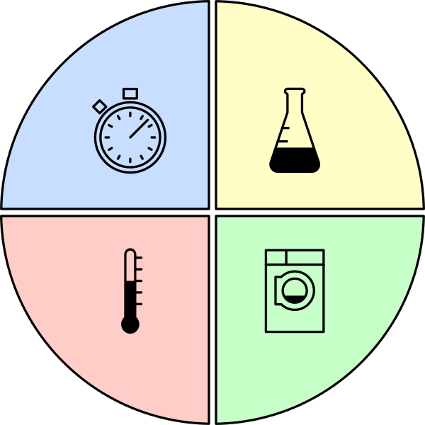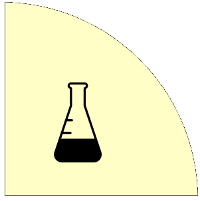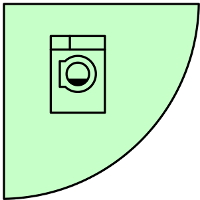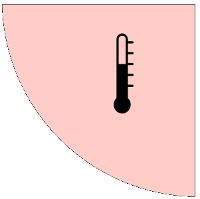The Sinner’s Circle
Most dry cleaners I have asked have never heard of the Sinner’s Circle, even though they use it every day. (The Circle is named for laundry expert Dr. Herbert Sinner, who worked for the Henkel company for over 30 years. Henkel owned Loctite, Dial soap, Purex and Snuggle fabric softener.)
The Sinner Circle is the secret to good laundry. You need to think about it when you put a load into your wash. Different garments, obviously, require different cycles. Understanding the Sinner’s Circle helps you to maximize your wash.
Round and round you go
Wikipedia says that Dr. Sinner first illustrated the cleaning process using a circle with four segments in 1959. The four segments are: Chemicals, Mechanical Action, Temperature and Time. Those four factors work together to remove soils in laundry.

When one of the four factors is reduced, the others have to increase to compensate for it. For example, if you want to reduce the wash time, you need to increase your chemistry or temperature or mechanical action. If you haven’t got enough hot water, then you need to increase the wash time, chemistry or mechanical action, etc.
Of course, there are limits each of these factors can accommodate. Too much mechanical action and the fabric is damaged. Too much heat and you may strip colour or damage some synthetic fibres. Too much chemistry and your costs get out of line. All of these factors need to be balanced to produce a good wash in an appropriate amount of time and at a price you can afford.
Those factors all contribute to removing soil. When there is more soil (such as with a chef’s uniform or greasy coveralls) the four segments have to be adjusted to compensate.
Another example is processing wool in water. You need to reduce mechanical action and temperature to prevent felting shrinkage. So the only way to adequately remove soil is to compensate with better chemistry and more time.
Chemistry 101

When I say ‘chemistry’ I mean:
- enzymes to break down soil,
- surfactants to help water penetrate the fibres,
- sour to neutralize the alkali, and
- texturizing agents.
Using the correct combination, in the correct cycle, will remove most soil and restore the garment to a useable condition. There are also specialized products to protect wool and silk from shrinkage, prevent dyes from bleeding and remove odours. We no longer depend on high temperatures, strong alkalis and chlorine bleach to get things clean.

Mechanical action is dependent on drum speed and the shape of the ribs in the basket. Water level also has an impact on mechanical action. It is important that the garments drop far enough to create some pressure to force the water through the fabric. If the water level is too high, the fabric may just roll over and not get clean. Mechanical action also holds the soil in suspension until the load is drained.
If the wheel is overloaded, the mechanical action is reduced and the cleaning results are poor. Overloading will not produce more pounds per hour; it will produce more pounds of poorly washed fabric per hour.

Temperature is vital in producing a good wash. In Alberta, our cold water drops to 5.5°C (42°F) in the winter. At that temperature, most detergents are not as effective. Even though we want to do a ‘cold’ wash, we may still have to heat the water up to 24°C (75°F).
The AL Wilson website states that increasing the temperature of a bath by 10°C will double the action of any bleaching agent. Detergents, degreasers, etc., are all more effective as the temperature increases.

Time is the one thing that many people don’t want to spend. If you want to reduce other costs, you will have to increase the time. A balance of all four factors is essential for good washing. Removing soils is a process and it takes time.
It’s not ‘set it and forget it’
What is an acceptable percentage of rewash in your facility? If you want every piece in a given load to come out perfect, then you are using too many resources; you would have to target the dirtiest piece, and that means every other piece is being over-processed. If you increase all of the four factors enough so that every piece is perfect then your ‘costs’ are too high on all the other pieces.
We want to process our loads in the quickest, least expensive and most effective manner. Sometimes it is better to spend more on chemistry and less on time. Think about using a little more degreaser and not having to scrub collars.
You have to decide the best balance for your situation – and each load. What can you afford the least of: time (equipment utilities), chemistry ($), mechanical action (possible fabric deterioration) or heat (hot water and its associated costs)?
Chemicals, Mechanical Action, Time and Temperature are the four principle factors that determine the success of a wash. You need to consider each of these as you process different garments, fabrics and soils. If you spin the Circle properly, hopefully, as Don Quixote once said, “All will come out in the Laundry.”






